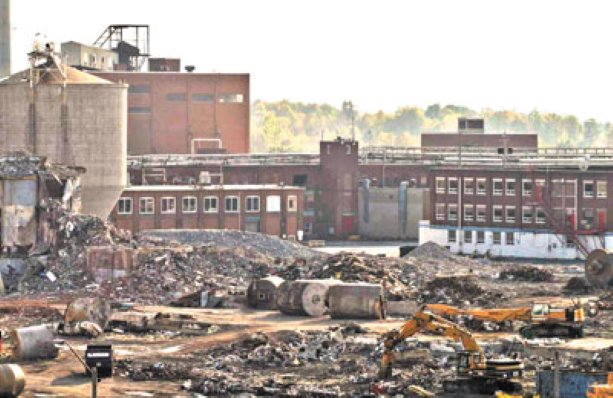The landscape in Cornwall, Ontario is changing on almost daily basis as work progresses on the demolition/remediation of approximately 120 acres of prime real estate located on the community’s southern boundary.
Complex Remediation
Future uses of Domtar site are undefined by developers
cornwall
The landscape in Cornwall, Ontario is changing on almost daily basis as work progresses on the demolition/remediation of approximately 120 acres of prime real estate located on the community’s southern boundary.
The former Domtar Fine Papers facility, which ceased operations after 123 years, was sold in September 2006 for $4 million to 2113467 Inc., also known as Paris Holdings.
Many of the larger buildings have been leveled and a stream of trucks leaving the site loaded with reclaimed metals and construction debris has become a part of normal activity in the eastern Ontario community of 46,000.
When work began in late 2006, the Ministry of the Environment was advised that demolition/remediation was expected to take between two to three years.
Barry Coleman, chief building official for the City of Cornwall, says that, from his perspective, things seem to be moving along smoothly.
“We issued a permit in July for the second phase of demolition, which included about six additional buildings,” says Coleman. “I don’t know what their schedule is for full completion.”
Calls to Paris Holdings were not returned.
As work on surrounding buildings continues, local residents are waiting for the day when the huge smokestack — that was for generations a symbol of prosperity — comes tumbling down. Based on current permits, they will have to wait a while longer.
“That’s not in there right now, in their permit to demolish, and it would certainly be required, but I don’t know when that is going to happen,” says Coleman.
While a new use for the property has not yet been fully explored, the city has made it quite clear it want to have a say in any future use.
A town hall-type meeting was held to invite input, but many of those who attended seemed to prefer a wait and see approach, hoping to keep possibilities open by not limiting future uses until much later in the process.
One hundred and twenty-three years of accumulated manufacturing waste could present a formidable and costly obstacle. The amount of remediation required will be determined not only from the site itself, but the ultimate use to be made of the property.
“City-wise, the issue is going to still be what is going to end up there in the end,” says Coleman.
“I know there was some stuff that went to PAC (Planning Advisory Committee) to try and have the owner on board and try to look at changing the zoning for it, but they didn’t want to participate in that at the present time because I don’t think they are sure what they want to do.”
At the time of the sale, many questioned why Domtar would sell a property for $4 million that was valued for taxation purposes at approximately $18 million. Where the debris would end up was a concern, but it appears that materials not worth salvaging didn’t end up going very far.
“Essentially, it is the Ministry of the Environment who would be responsible to see where the demolition material goes to, but what I have here is Domtar/Big Ben solid waste facility,” says Coleman.
“They did have a licence through MOE, I believe, and there was some reapplication, some interest in what more they could bring over there, so they are showing that as being the waste facility.”
‘Big Ben’ is the huge mound of Domtar waste materials that had been turned into a downhill ski facility just west of the Brookdale avenue corridor.
“I don’t know if you’ve seen it, but if you drive on the bridge you can certainly see a major dent in the old mill,” says Coleman.
A bridge that connects Cornwall with the Native territory of Akwesasne is to be demolished soon and replaced with a new low-level bridge.











Recent Comments
comments for this post are closed